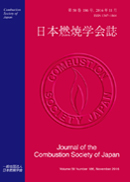Volume 65, Issue 211
Displaying 1-8 of 8 articles from this issue
- |<
- <
- 1
- >
- >|
FEATURE —Evolving Fire Extinguishing Technology
-
Article type: FEATURE―Evolving Fire Extinguishing Technology
2023 Volume 65 Issue 211 Pages 9-16
Published: February 15, 2023
Released on J-STAGE: April 18, 2023
Download PDF (18323K) -
Article type: FEATURE―Evolving Fire Extinguishing Technology
2023 Volume 65 Issue 211 Pages 17-23
Published: February 15, 2023
Released on J-STAGE: April 18, 2023
Download PDF (6049K) -
Article type: FEATURE―Evolving Fire Extinguishing Technology
2023 Volume 65 Issue 211 Pages 24-28
Published: February 15, 2023
Released on J-STAGE: April 18, 2023
Download PDF (7503K) -
Article type: FEATURE―Evolving Fire Extinguishing Technology
2023 Volume 65 Issue 211 Pages 29-36
Published: February 15, 2023
Released on J-STAGE: April 18, 2023
Download PDF (5979K) -
Article type: FEATURE―Evolving Fire Extinguishing Technology
2023 Volume 65 Issue 211 Pages 37-40
Published: February 15, 2023
Released on J-STAGE: April 18, 2023
Download PDF (2265K) -
Article type: FEATURE―Evolving Fire Extinguishing Technology
2023 Volume 65 Issue 211 Pages 41-48
Published: February 15, 2023
Released on J-STAGE: April 18, 2023
Download PDF (10167K)
SERIAL LECTURE —Physics and Chemistry of Liquid Fuel Combustion I
-
Article type: SERIAL LECTURE ―Physics and Chemistry of Liquid Fuel Combustion I
2023 Volume 65 Issue 211 Pages 49-56
Published: February 15, 2023
Released on J-STAGE: April 18, 2023
Download PDF (7694K) -
Article type: SERIAL LECTURE ―Physics and Chemistry of Liquid Fuel Combustion I
2023 Volume 65 Issue 211 Pages 57-63
Published: February 15, 2023
Released on J-STAGE: April 18, 2023
Download PDF (10143K)
- |<
- <
- 1
- >
- >|
